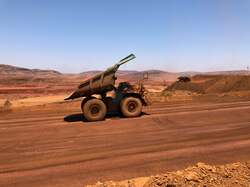
Western Australia in Australia is a major producer of iron ore. Western Australia’s annual export volume reaches nearly 900 million tons, and it accounts for about 50% of the world’s maritime trade volume (in 2021). The iron ore is held in high regard for its cost competitiveness as well. Japanese integrated steel producers import just over 60 million tons of iron ore each year from mostly Western Australia, and this amount accounts for around 70% of their total annual import volume. In recent years, among Western Australia’s iron ore suppliers, it is becoming the norm to conduct efficient operations utilizing DX (digital transformation). The following is an on-site report of the measures being pursued by Rio Tinto, Australia’s largest and most cutting edge iron ore supplier.
Perth is the capital city of Western Australia, and people visiting the city by air first land in Perth Airport. Rio Tinto’s Operations Center for its iron ore business is located near the aforementioned airport. The Operations Center serves as the ‘brain’ and centrally manages the operations of the company’s 17 iron ore mines in Western Australia.
The iron ore mines are concentrated in the Pilbara region, which is located at a distance of about 800 km from Perth. Despite this vast distance, the Operations Center is able to manage all operations in real-time, including the operations of various transportation infrastructure, such as railroads and ports.
The Operations Center has about 150 staff members. The operations room is divided into a dozen or so blocks, and the staff members examine their computer screens to manage the operations of mines, ports and others around the clock.
At the time we visited the Operations Center, 8 staff members that were part of the team in charge of Gudai-Darri iron ore mine, which began operations last year, were monitoring the operations of the mine with their computers.
The manager that guided us through the Operations Center stated “Due to centrally managing operations at Perth, we have been able to significantly reduce the number of staff members in charge of operations that are needed to be permanently stationed at the mines. In addition to managing operations, one other important role we serve is detecting problems before they occur.” Detecting problems before their occurrence is essential for ensuring steady operations.
At each of the company’s mines, several tens of millions of tons of iron ore are mined/produced each year, so ensuring steady operations is a key part of realizing cost competitiveness. In addition, mining operations cover a wide range of activities. For example, the management of utilities, such as electricity and water, are also important for keeping mines in operation. These activities are the ‘blood’ that keeps the mines in operation, and the Operations Center is in charge of ensuring that the ‘blood’ keeps running smoothly.
The iron ores produced at multiple iron ore mines owned by Rio Tinto are blended at a port for loading shipments, and after their grades are optimized into ‘Pilbara Blend’ iron ores, they are then shipped to their respective destinations. Managing the blending operations is one other important role played by the Operations Center.
The Operations Center’s responsibilities are not limited to improving the efficiency of operations. The Operations Center also supports the mines by ensuring their ‘safety’, which is a top priority in terms of operating mines. Automating mine and transportation infrastructure operations reduces the areas where work need to be carried about by humans, and thus contributes to ensuring their safety. Therefore the Operations Center, which supports the company’s automation efforts, also contributes to ensuring ‘safety’ as well.
Rio Tinto established its Operations Center in 2010, becoming the first company in the iron ore industry to do so. From then on, Rio Tinto’s competitors have followed suit. However, after the establishment of the Operations Center, Rio Tinto has rapidly conducted a series of additional measures to pursue automation, including utilizing self-driving dump trucks, machines for automatically loading dynamite and also autonomous rail cars. Some say that in terms of implementing IT (information technology) measures, those that follow pioneering organizations have an advantage, but Rio Tinto has accumulated various know-how through the measures that they have conducted over the years, and these know-how provide a significant advantage. Even now Rio Tinto has a lead over its competitors as the front-runner.